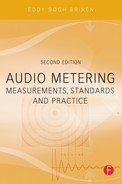Chapter | twenty-nine
Sound Level Meters
CHAPTER OUTLINE
Sound levels can be measured with a sound pressure meter, most often simply called a sound meter. A sound meter contains a microphone, amplifier circuit, and filter circuit, as well as a detector and display in the form of a moving coil type of instrument or a digital display. In addition, a sound meter can be equipped with some form of computational function, so calculations can be performed on sound levels recorded over a time period. There is thus a differentiation between sound pressure meters and integrating sound pressure meters.
MICROPHONE
A sound meter is equipped with a pressure microphone, i.e., a microphone with omnidirectional characteristics. Normally, a decision must be made concerning whether a microphone with flat free field or flat diffuse field characteristics is desired. For measurements outdoors, a wind cap is used in order to avoid wind noise in the microphone having an undesired effect on the results of the measurements. In order to be able to check the sound pressure meter’s display, an acoustic calibrator is used. It is a small sound generator with a well-defined frequency and level.
AVERAGING
The detector rectifies the signal, averages it, and calculates an RMS value. There are two forms of averaging. One is linear averaging and the other is exponential averaging. With linear averaging, the RMS value is found for a fixed time interval that is called the integration time. It is this form of averaging that is used in level instruments. For example, the standardized integration time is 5 ms for a PPM instrument according to IEC standard 60268-10.
In connection with the measurement of sound, exponential averaging is used. This means that the incoming signal is weighted so that the RMS signal “remembers the past,” but events that lie further back in time will have less weight than events that have just occurred. The average time or the time constant is a measure of how fast the exponential function “decays,” or more precisely, it specifies the time it takes before the exponential function has been reduced to 69% of the starting value. Internationally, the time constants used include 125 ms (called “F” for “Fast”) and 1 second (called “S” for “Slow”).
In integrating sound meters, measurements can be made over long periods of time (minutes/hours), and the result expresses the energy as that which a constant level would have had during the time period.
FREQUENCY WEIGHTING
Since the sensitivity of the ear is not the same at all frequencies, a filter can be inserted that takes this into account. The filter used most often performs an A-weighting, where the lowest and highest frequencies are attenuated, whereas frequencies in the 1–4 kHz range are amplified. Other filters are also used including B, C, D, and Z filters.
When, for example, an A filter has been used, the result of the sound pressure level read from the meter is written as xx dB(A) or as LpA: xx dB. A sound meter can also be equipped with octave or 1/3 octave filters for use in the frequency analysis of the signal.
READING
The reading of the results is performed in dB. As a reference level for the measurement of sound pressure, the value 20 µPa (2 10 −5 Pa) is always used.
OUTPUT
Normally, an AC output is available so the sound meter can function as a microphone pre-amplifier and so the signal can be recorded for later analysis. A DC output is often found too, so that a printer can record what the instrument’s display is showing.

FIGURE 29.1 The VU-scale on the Standard Volume Indicator ranges from – 20 to +3.
CLASSES OF SOUND LEVEL METERS
The requirements for precision for sound pressure meters and for integrating sound pressure meters are given in the following two international standards:
IEC 60 651 Sound level meters
IEC 60 804 Integrating-averaging sound level meters.
The norms specify nominal values and tolerances for a number of characteristics:
Type 0 is intended as a laboratory reference standard.
Type 1 is intended for precise measurements in the laboratory and in the field.
Type 2 is envisioned for general measurements in the field.
Type 3 can only be used for a rough orientation concerning noise levels.
Type 0 has the narrowest tolerances. In most countries, it is required that measurements in the external environment must be performed with measurement equipment that adheres to the type 1 tolerances.
ANALYSES
In connection with the measurement of noise, different analyses are performed, including analyses of a more statistical nature. The most significant ones are listed below.
Lp SPL or Sound Pressure Level. The RMS value of the sound pressure concerned expressed in dB re 20 mPa.
Leq The equivalent sound pressure level, i.e., the average value (on an energy basis) of the sound pressure level registered over a period of time.
LE (previously called SEL). An expression of the total energy in the period being calculated.
Ln With a basis in the cumulative occurrence distribution, Ln specifies the sound level that has been exceeded in n% of the time interval under consideration. n can assume values from 1 to 99. Ln is often used to describe the background noise during periods with varying noise; for example, L95 = 36 dB means that this value was exceeded during 95% of the measurement period.
